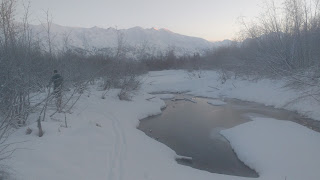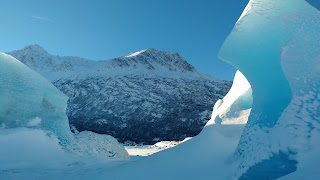We did this in mid-September, which turned out to be a nice time, with no snow. I've read other reports saying springtime is the best time, and I'd love to see if that's correct. I personally imagine that the snow would make me feel a lot less stable on the knife-edge ridges. I knew I was in for sketchy areas on this traverse, but there were definitely a few sections that could end badly if you happened to slip. While the ridge generally gets easier the farther from Penguin Peak you get (if you're heading toward Girdwood, which is what I'd prefer, since you get the hardest part out of the way), the most challenging section for me was downclimbing a very steep section that ended on a knife-edge ridge, just about halfway from both trailheads. It came out of nowhere, and I didn't expect it. In hindsight, this whole ridge was just fine, and I'd do it late in the summer again, for sure. But don't forget: it's LONG. It took us 14 hours, and I felt we were going at a comfortably fast pace. 12 hours would be the fastest you could expect, walking.
I made sure we would be prepared. There were 5 of us that came, and I brought 1.5 gallons (I actually ended the hike with about 2 liters to spare! What a waste!). Sarah and I staged a car on the beginning of the California Creek Trail in the morning, and met up with the others at the Bird Creek Trail.
From the Bird Creek Trailhead, follow for about 1 mile, until you see a trail marker for Penguin Peak Trail that takes off on the right. Be aware: this area has the highest number of bear maulings of any area in Alaska. The Penguin Peak trail weaves through dense Alders as you follow the gully to the top of the ridge. There's no best way up to Penguin Peak, but I prefer to get up on the ridge as soon as possible. Once on the ridge, simply stay as close to Turnagain Arm as you can, unless that involves falling off a cliff face. We got fogged in the Girdwood half of the peak, and ended up unintentionally losing our bearings up on Emporer Peak, which is slightly out of the way. I had to get the GPS out to figure out where exactly we were.
It does get confusing around Gentoo Peak. You can either go up and over Gentoo, and drop down a very steep gully, which definitely has slippery tundra and dirt, or you can bypass Gentoo Peak, which is what we did, and side-sloped down to intersect the gully from below. Either way is quite a steep descent. When looking at aerial imagery: aim for the triangular shaped open meadow. It is waist-deep with ferns/parsnip/grasses, but if it's late in the season, someone will have stomped down a trail up to the gully. On the far downward side of the open meadow, there is a well-established trail.
Once you've found the trail, be prepared for mud. Ankle-deep mud. There are numerous trail options down, but I've learned that all lead to the same area. Just keep aiming downstream, and you'll intersect the Crow Creek Road at the intersection of California Creek.
This adventure took us 14 hours. When we had about 12 hours of light. We started in the dark, and ended in the dark. Plan on a long day!
The more dangerous sections have arrows pointing to them























































































